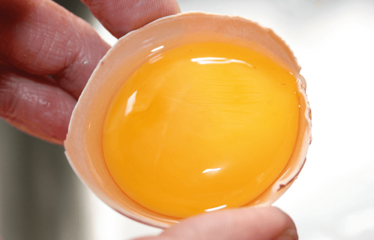How Do You Like Your Eggs?
Scientists in California have ‘unboiled’ an egg – with some interesting implications for biopharma...

A recent paper revealed a new way to ‘unboil’ egg whites (1), capturing the attention of the popular media – and The Medicine Maker – in the process. So, how did this remarkable feat come about?
A common problem in labs working with proteins is that newly synthesized chains bind to each other and become tangled, forming a messy protein aggregate. “This drives us nuts,” says Gregory Weiss, lead author of the paper and professor at the University of California Irvine. “It’s been a problem since I was a graduate student and it’s still a problem today, 20 years later.”
The method for untangling the proteins hasn’t changed in that time either. The solid protein aggregate is dissolved in urea, which coats the protein chains and causes them to untangle – going from a gummy solid substance to a liquid. The urea is then slowly removed to allow the chains to re-form in the correct structure, a tedious process taking four or five days of valuable research time.
A trip to Australia two years ago presented Weiss with a potential solution. “I found myself in the office of a very creative synthetic chemist, Colin Raston, who was telling me about a new machine he had invented: the vortex fluid device. He told me how he was able to use it to pull apart one atom-thick sheets of graphite to produce graphene.” It immediately struck Weiss that the vortex fluid device might work on proteins too and he asked Raston to send him one. “He packaged one up and a graduate student brought it over to my lab,” says Weiss.
“The only problem was that it looked exactly like a bomb, with wires sticking out and a clock-like controller, so we were a bit worried what airport security might think...” But the student and device arrived safely in Southern California and Weiss’s team went to work, “Within a month we were getting really exciting data, showing that we could get proteins to refold in record times.”
In the new process, the protein–urea solution is rapidly diluted into water, which would normally cause the protein chains to re-tangle; however, the vortex fluid device pulls the proteins away from each other, giving them space to refold into their natural configuration. Weiss and his team tried out the process, which takes minutes rather than days, on several different proteins and were delighted with the results. They decided to publish the work so others could benefit, which is where the egg came in.
“The cancer-associated proteins my lab works with are very different to most proteins that scientists are familiar with,” explains Weiss. “I realized that if we wanted to show the peer reviewers that we had a generalizable technique with the power to tackle really tough challenges, we needed to try it on a protein that everyone knows. A hard-boiled egg seemed the perfect model.” When an egg is boiled, the proteins become tangled and disordered – the team proved that a key component of the egg white, lysozyme, could be returned to its original configuration using the vortex fluid device.
While unboiling an egg may not be particularly useful in itself, the technique could have a huge range of potential applications. “From our initial work, it looks like the technique can be used on many proteins,” says Weiss. One avenue the team are keen to explore is in biopharma manufacturing. “Biologics often require exotic cell lines and special conditions to make sure proteins fold correctly and don’t become tangled,” explains Weiss. “Instead of getting the cells to do all the hard work of correctly folding proteins, we could get the vortex fluid device to use mechanical energy to force the proteins to fold after the protein is expressed from the cell.” And that could mean more efficient production and consequently lower costs. “We’ve already had some interesting calls from drug companies and we’re excited about the future,” says Weiss.
- T. Z. Yuan et al., “Shear-Stress-Mediated Refolding of Proteins from Aggregates and Inclusion Bodies”, ChemBioChem 16 (3), 393–396 (2015).

As an Editor at Texere, I’m working closely with our audience to create vibrant, engaging content that reflects the hard work and passion that goes into bringing new medicines to market. I got my start in biomedical publishing as a commissioning editor for healthcare journals and have spent my career covering everything from early-stage research to clinical medicine, so I know my way around. And I can’t think of a more interesting, challenging or important area to be working in.



















